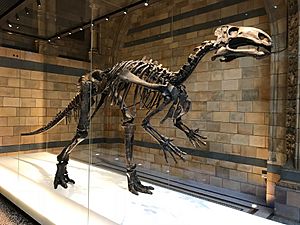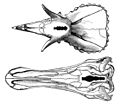Ankylopollexia facts for kids
Quick facts for kids Ankylopollexia |
|
|---|---|
 |
|
| Mantellisaurus skeleton, Natural History Museum, London | |
| Scientific classification |
|
| Kingdom: | Animalia |
| Phylum: | Chordata |
| Clade: | Dinosauria |
| Order: | †Ornithischia |
| Suborder: | †Ornithopoda |
| Clade: | †Dryomorpha |
| Clade: | †Ankylopollexia Sereno, 1986 |
| Subgroups | |
|
|
Ankylopollexia is a group of extinct dinosaurs. They are part of a larger dinosaur family called Ornithischia. These amazing creatures lived between 156 and 66 million years ago. This means they were around during the Late Jurassic and Late Cretaceous periods.
The name Ankylopollexia comes from two old words. "Ankylos" is a Greek word meaning "stiff" or "fused." "Pollex" is a Latin word meaning "thumb." So, the name points to a special feature of these dinosaurs: their stiff thumbs!
Contents
What are Ankylopollexia?
Ankylopollexia is a clade of dinosaurs. A clade is like a family tree branch. It includes a common ancestor and all of its descendants. So, all dinosaurs in the Ankylopollexia group share a common ancestor. They also share certain features that make them unique.
Key Features of Ankylopollexia
One of the most famous dinosaurs in this group is the Iguanodon. This dinosaur is known for its distinctive thumb spike. This spike was likely used for defense or for stripping leaves from plants. Many other dinosaurs also belong to this group.
- Camptosaurus
- Cumnoria
- Draconyx
- Uteodon
These dinosaurs show how the group changed over millions of years.
Who are the Hadrosaurs?
Another very important part of the Ankylopollexia group are the Hadrosaurs. These dinosaurs are often called "duck-billed dinosaurs." They are known for their wide, flat snouts. Hadrosaurs were very successful plant-eating dinosaurs. They lived during the Late Cretaceous period.
When Did They Live?
Ankylopollexia dinosaurs lived for a very long time. Their time on Earth stretched from about 156 million years ago to 66 million years ago. This period covers parts of the Jurassic and Cretaceous periods. During this time, Earth looked very different. There were different plants and other animals.
Life in the Jurassic Period
The Late Jurassic period was a time of giant plant-eating dinosaurs. These included long-necked sauropods. Ankylopollexia dinosaurs like Camptosaurus were also around. They would have shared their habitats with these large creatures.
Life in the Cretaceous Period
As time moved into the Cretaceous period, new types of dinosaurs appeared. This included the Hadrosaurs. They became very common. The Ankylopollexia group continued to evolve. They adapted to new environments and food sources.
Images for kids
-
Hand of Iguanodon, showing the distinctive thumb of the group
-
Life restoration of Camptosaurus
See also
 In Spanish: Ankylopollexia para niños
In Spanish: Ankylopollexia para niños







